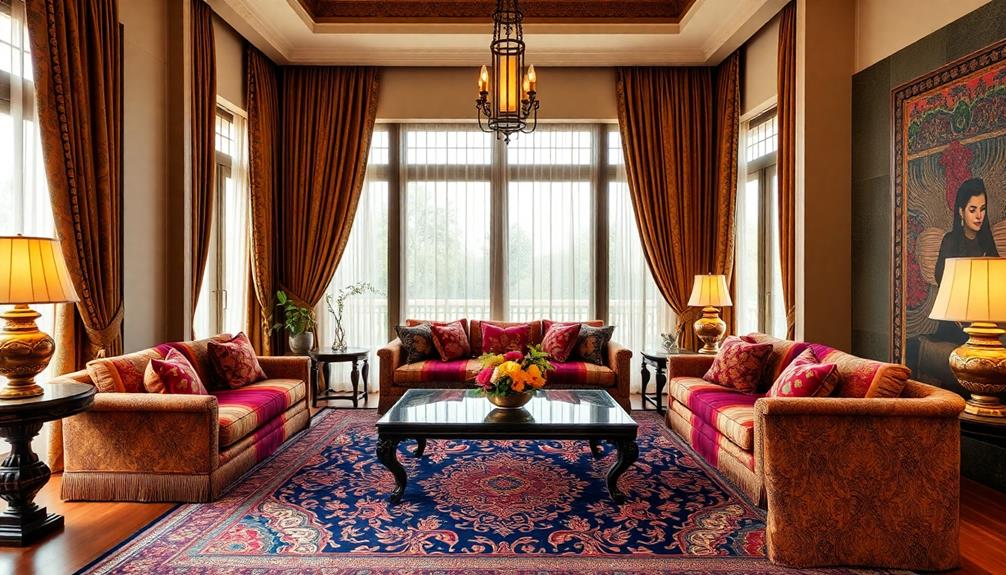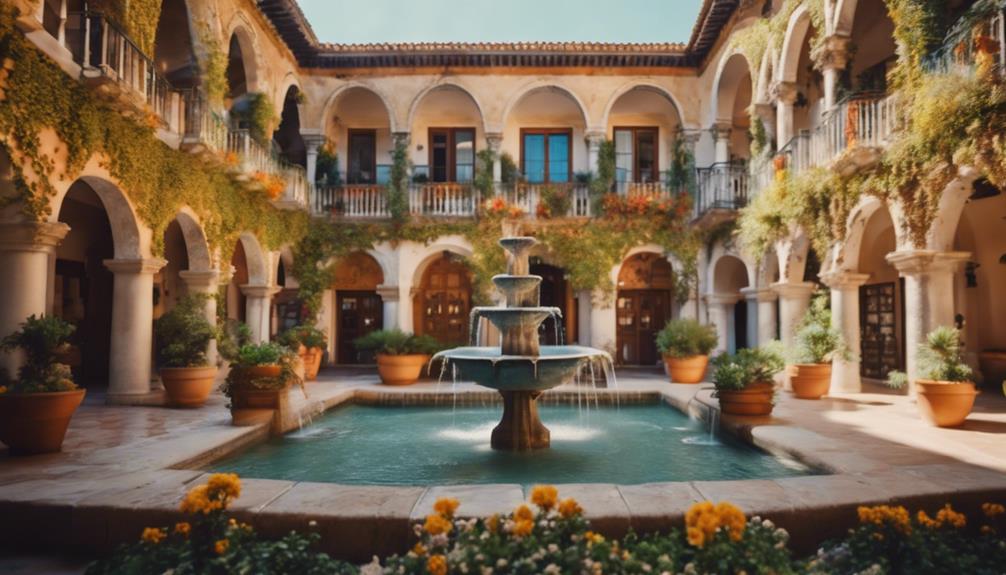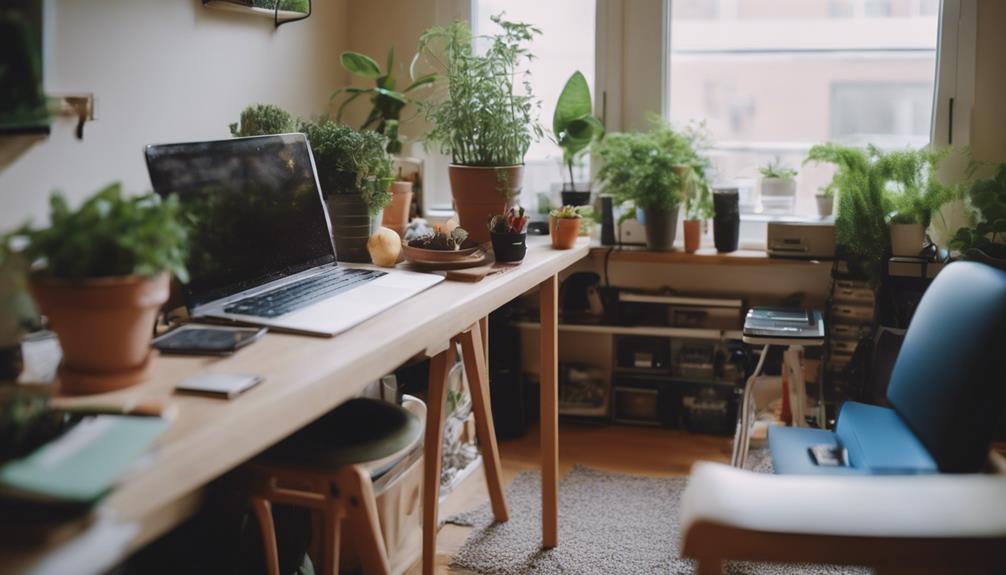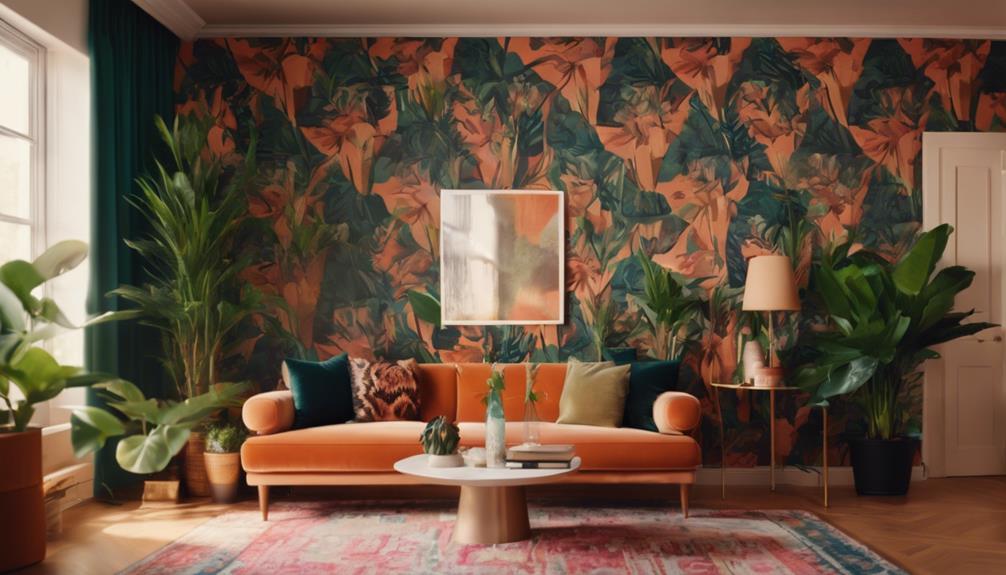Incorporating rare Indonesian textiles like batik, ikat, and songket can instantly elevate your space and infuse it with cultural richness. Each fabric carries intricate designs and vibrant colors that bring warmth and sophistication. Batik’s unique wax-resist patterns and ikat’s striking colors make stunning statement pieces, while the luxurious silk of songket adds an upscale touch. Layering these textiles with natural materials enhances their beauty and creates a cohesive look. Using these artisan-crafted fabrics not only boosts your interior’s elegance but also connects you to a rich cultural heritage, revealing even more ways to enhance your decor.
Key Takeaways
- Indonesian textiles like batik, ikat, and songket feature intricate designs that add sophistication and uniqueness to any interior space.
- The luxurious nature of songket, woven with gold or silver threads, creates an upscale atmosphere in home décor.
- Layering traditional textiles alongside natural materials enhances warmth and visual interest, elevating overall design aesthetics.
- The vibrant color palettes and rich textures of Indonesian textiles infuse energy and elegance, transforming spaces into luxurious environments.
- Incorporating these textiles not only showcases craftsmanship but also connects spaces to rich cultural heritage, enhancing perceived value.
The Allure of Indonesian Textiles

There's something undeniably enchanting about Indonesian textiles that draws you in. These traditional Indonesian textiles, like batik, ikat, and songket, showcase intricate designs and craftsmanship that reflect the rich cultural heritage of the archipelago. Each piece tells a story, connecting you to the diverse ethnic groups that have preserved these artistic traditions for generations.
Additionally, incorporating affordable Indonesian decor masks can further enhance the artistic appeal of your space. Take batik, for instance. Recognized by UNESCO as an Intangible Cultural Heritage, its labor-intensive wax-resist dyeing technique creates unique patterns that can effortlessly elevate your space's aesthetic appeal. The vibrant color palettes, featuring rich reds, deep blues, and earthy tones, invite warmth and luxury into any interior.
Incorporating traditional Indonesian textiles into your décor, whether through upholstery, cushions, or wall hangings, adds an artistic flair that sparks conversations. Each textile not only enhances your design but also highlights the artistry and cultural significance behind it. Indonesian fabrics for interior decor often feature intricate patterns and rich colors that can transform any space with a touch of authenticity and elegance. These textiles, such as batik or ikat, represent centuries of craftsmanship, making them a meaningful addition to your home. By choosing Indonesian fabrics for interior decor, you are not only celebrating a rich cultural legacy but also supporting artisans who continue to preserve these time-honored traditions.
Plus, using natural materials and traditional techniques guarantees you're embracing sustainable design practices. So, when you choose these stunning textiles, you're not just decorating; you're celebrating a beautiful heritage that connects you to nature and supports ethical sourcing.
Distinct Types of Indonesian Fabrics

When you explore Indonesian fabrics, you'll discover their unique characteristics and rich cultural significance.
Each type, like Ikat, Songket, and Batik, serves not just as clothing but also enhances interior design with their vibrant patterns and textures.
These textiles are often handcrafted by skilled artisans, making them a true representation of traditional craftsmanship.
Unique Fabric Characteristics
Exploring the unique fabric characteristics of Indonesian textiles reveals a vibrant tapestry of cultural heritage, where each type offers its own distinct charm.
Traditional Indonesian textiles, such as ikat, songket, and batik, showcase exceptional craftsmanship and artistry, often enhanced by Indonesian decorative pillows that incorporate similar vibrant colors and intricate patterns.
Ikat textiles stand out with their vibrant, intricate patterns created using a tie-dyeing technique. These patterns often reflect the cultural significance and status of the weaver's village, making each piece a unique story.
In contrast, songket is woven from luxurious silk and adorned with gold or silver threads, instantly adding opulence and traditional elegance to any setting.
Batik employs a labor-intensive wax-resist dyeing method, resulting in detailed designs that vary by region. This technique gives each batik fabric its own unique aesthetic, echoing the rich heritage of Indonesia.
What's remarkable about these traditional Indonesian textiles is their embodiment of cultural identity, with specific colors and motifs carrying deep meanings.
Plus, the use of natural dyes and traditional craftsmanship not only enhances their beauty but also supports sustainable practices, making them a stylish and conscious choice for your interior design.
Cultural Significance of Textiles
Throughout Indonesia, textiles like batik, ikat, and songket serve as vibrant expressions of cultural identity and heritage. Each type of traditional Indonesian fabric carries deep significance, reflecting the unique artistry and traditions of various ethnic groups.
Batik, recognized by UNESCO as an Intangible Cultural Heritage, showcases intricate designs through a labor-intensive wax-resist dyeing technique that's been practiced for over a millennium. These designs often symbolize social status and cultural narratives, making batik a living embodiment of Indonesia's history. Additionally, these textiles often incorporate motifs that depict local myths and folklore, similar to the stories told through Indonesian decor masks.
Ikat textiles, characterized by their distinctive tie-dyed threads, are traditionally crafted by women using handspun cotton and natural dyes. The designs can vary widely by village, each holding cultural implications tied to local customs and status.
Meanwhile, songket offers a luxurious touch, featuring handwoven silk adorned with gold or silver threads. It's often reserved for ceremonial attire, demonstrating the intricate craftsmanship and rich traditions of Indonesia.
These traditional Indonesian textiles aren't merely decorative; they play a significant role in rites of passage and cultural events, underscoring their importance in daily life and ceremonial occasions alike.
Applications in Interior Design
Indonesian textiles bring a unique flair to interior design, seamlessly blending cultural richness with modern aesthetics. By incorporating traditional Indonesian textiles like batik prints into upholstery and wall hangings, you can enhance the visual interest and cultural identity of your space. This touch of Indonesian heritage adds depth and character to contemporary designs, while also reflecting Balinese design characteristics that emphasize craftsmanship and connection to nature.
Ikat textiles, known for their intricate patterns and vibrant colors, make perfect statement pieces for throw pillows or curtains, instantly elevating your interior arrangements.
Songket fabrics, with their luxurious silk and metallic threads, serve as stunning accents for table runners or decorative throws, creating an upscale atmosphere.
Layering traditional textiles in your design, such as richly woven rugs and tapestries, fosters a cohesive and immersive environment that showcases the beauty of Indonesian craftsmanship.
To enhance the warmth and elegance of your interiors, consider pairing these textiles with natural materials like antique wood and bamboo. This combination not only emphasizes the textiles but also makes your space feel more inviting and sophisticated.
In short, utilizing these distinct types of Indonesian fabrics can transform your home into a luxurious haven that tells a story of culture and artistry.
Elevating Spaces With Ikat
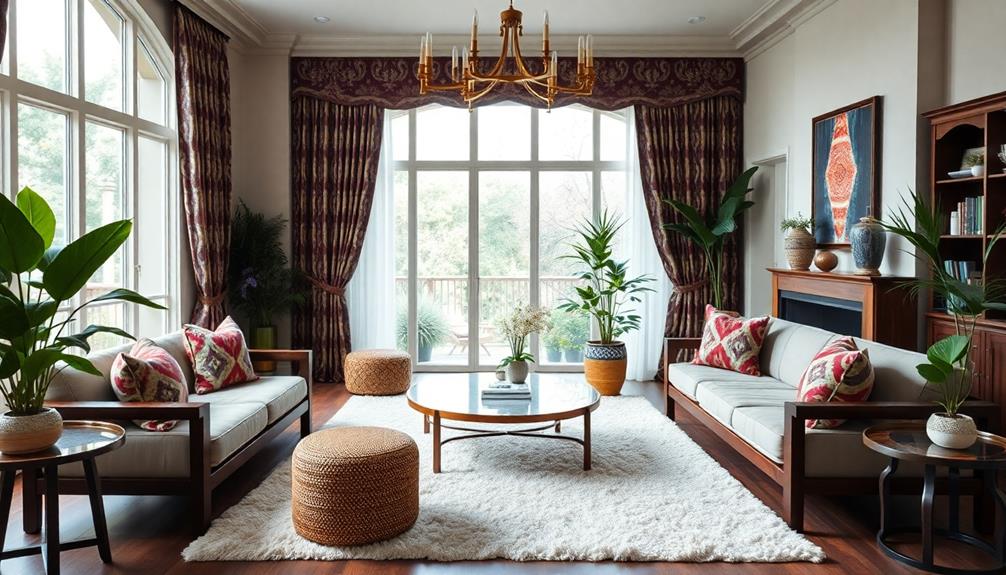
Ikat patterns are more than just beautiful; they bring a sense of cultural richness to your space. By incorporating these timeless textiles, you not only enhance your decor but also celebrate the craftsmanship and heritage behind each piece.
These textiles can beautifully complement the natural materials often found in traditional Indonesian style home decor, creating a harmonious ambiance. Whether used in upholstery or wall hangings, ikat can transform your home into a luxurious sanctuary.
Timeless Ikat Patterns
Transform your living space with the rich, intricate patterns of ikat textiles. These traditional textiles, characterized by their unique tie-dyed threads and elaborate designs, bring a sense of history and artistry to your decor.
Originating from Nusa Tenggara, each ikat piece is handwoven using natural dyes, making it not just a decorative item but a one-of-a-kind work of art. Infusing your home with ikat patterns also connects you to the cultural significance of traditional Indonesian housing, where craftsmanship and heritage are deeply valued, reflecting regional identity and social status cultural significance of housing.
When you incorporate ikat patterns into your home, whether through upholstery, curtains, or wall hangings, you instantly elevate the ambiance, adding a touch of luxury and cultural depth. The common hues of rich browns and indigos resonate with timeless elegance, while modern artisans also explore vibrant synthetic dyes to fit contemporary tastes.
The craftsmanship behind ikat is remarkable, reflecting labor-intensive techniques passed down through generations. By choosing these textiles, you're not only enhancing your space but also supporting sustainable practices and ethical production.
Embrace the beauty of ikat and allow its distinctive patterns to transform your home into a sophisticated haven that speaks to both tradition and modernity.
Cultural Richness in Design
Bringing the intricate beauty of ikat textiles into your home enriches not just your decor but also the cultural narrative of your space. Originating from Nusa Tenggara, these textiles are characterized by their tie-dyed threads and elaborate patterns, each piece telling a story of its cultural significance and craftsmanship.
When you incorporate ikat into your home, you're not just adding color; you're inviting a sense of exclusivity and status that varies by village. Many interior design consultants in Bali, like Mahallati Interiors, emphasize the beauty of integrating local textiles into contemporary spaces, showcasing the artistry of Indonesian culture.
Traditionally handmade by women using natural dyes, ikat textiles showcase the artistry of Indonesian culture. You'll find that these textiles enhance your interiors with rich colors and detailed motifs, creating a warm, inviting atmosphere.
Whether you opt for cushions or wall hangings, each piece infuses your space with a vibrant cultural narrative.
In today's design landscape, the use of ikat highlights a beautiful blend of tradition and contemporary style. Traditional methods are still employed in crafting these textiles, ensuring that each item retains its authenticity while complementing modern aesthetics.
The Timeless Charm of Batik

Batik captivates with its intricate patterns and rich history, making it a timeless treasure in Indonesian culture. Recognized as an Intangible Cultural Heritage of Humanity by UNESCO in 2009, the batik craft showcases meticulous craftsmanship that tells stories of regional identities and cultural narratives.
Originating from Central Java, this textile art employs a labor-intensive wax-resist dyeing technique, resulting in detailed designs that reflect the diverse heritage of Indonesia. The vibrant color palette of batik can complement various design styles, including tropical villa plans, where open spaces and natural light create a serene atmosphere.
You'll find that the vibrant color palette of batik varies by region; for instance, northern Java is known for its bold hues. Traditional designs often feature stylized images that carry cultural significance, enhancing their allure. Recently, batik has experienced a resurgence in popularity, with modern designers blending traditional artistry with contemporary fashion trends. This fusion appeals to a wide audience and keeps the craft alive.
Integrating batik into your home decor not only elevates the aesthetic appeal of your space but also preserves its cultural heritage. Whether you choose batik cushions, wall hangings, or upholstery, you're adding a unique touch that speaks to history while making your space feel more luxurious and inviting.
Cultural Significance of Textiles
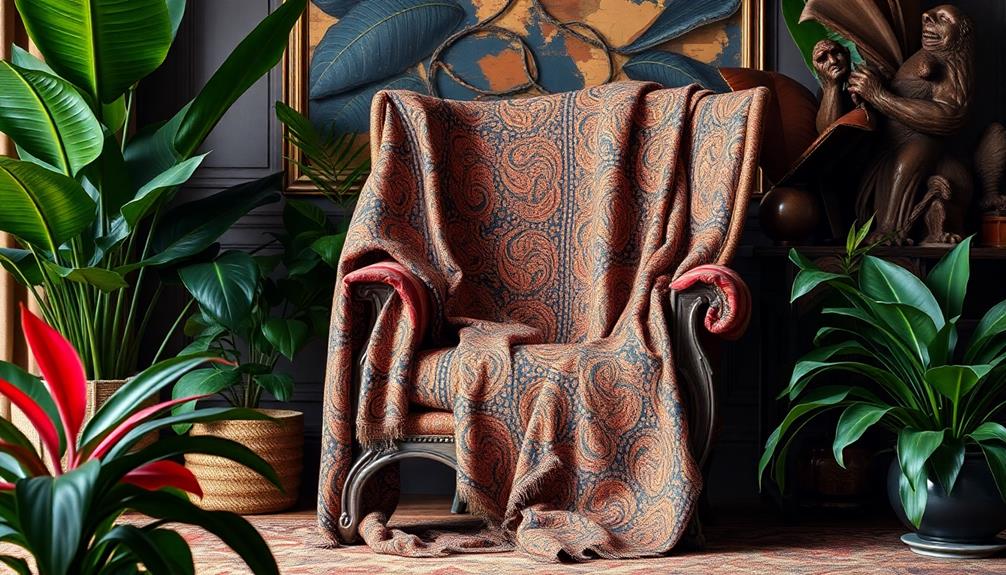
When you explore Indonesian textiles, you'll find that they're not just beautiful fabrics; they embody rich heritage craftsmanship and deep symbolism.
Each design tells a story, often linked to important ceremonies and cultural identities. Understanding their significance can deepen your appreciation for these unique pieces of art.
Heritage Craftsmanship Importance
Rooted in Indonesia's diverse cultural landscape, the craftsmanship of textiles like batik and ikat reflects an artistic legacy that's essential to the nation's identity. These traditional Indonesian textiles are not just fabric; they embody centuries of history, skill, and cultural significance. Recognized by UNESCO as Intangible Cultural Heritage of Humanity, they showcase the intricate techniques involved, such as wax-resist dyeing for batik and tie-dye methods for ikat.
Each textile serves a unique cultural purpose, often linked to important life events, which highlights the connection between art and social customs. The storytelling aspect is profound, as patterns often depict mythological figures and everyday life, enriching their appeal in your home decor.
| Type of Textile | Cultural Significance |
|---|---|
| Batik | Represents identity and heritage |
| Ikat | Ties to specific life events |
| Pakaian Adat | Showcases regional diversity |
Incorporating these textiles into your space not only elevates its aesthetic but also honors the craftsmanship and cultural narratives they carry. By choosing traditional Indonesian textiles, you celebrate a rich heritage that adds depth to your interior design.
Symbolism in Designs
Indonesian textiles aren't just beautiful; they're rich with symbolism that conveys deep cultural meanings. Each piece, from batik to ikat, is a tapestry of stories reflecting the cultural heritage of its creators.
Indonesian wedding decor ideas often showcase these textiles, highlighting their importance in ceremonies and celebrations. The symbolism in designs often links specific colors and patterns to local traditions and beliefs. For example, in batik, certain motifs are reserved for nobility or ceremonial occasions, highlighting social status and community values.
Textile makers diligently craft ikat designs that vary by region, each carrying significant narratives that express the identity of the ethnic group behind them. These intricate patterns and vibrant colors, like red for bravery or blue for tranquility, don't just enhance your space aesthetically; they infuse it with history and emotional resonance.
When you incorporate these textiles into your home, you're not just decorating; you're weaving a rich narrative of Indonesian culture into your surroundings. The layers of meaning behind each design elevate your space, making it feel more luxurious and thoughtful.
Textiles in Ceremonial Events
Textiles hold a central place in ceremonial events across Indonesia, symbolizing status and cultural identity for various ethnic groups. When you attend a wedding or funeral, you might notice the stunning batik and ikat fabrics that adorn the participants. These textiles aren't just for show; they represent deep-rooted traditions linked to significant life events, like births, marriages, and deaths.
Each intricate pattern and vibrant color carries distinct meanings, reflecting the beliefs and values of the community. For instance, batik from Central Java has a long-standing association with nobility, often reserved for ceremonial attire that showcases the artistry involved in its creation. By wearing these textiles, individuals proudly express their cultural identity and heritage.
During ceremonies, textiles often take center stage, acting as visual representations of heritage and collective memory. They reinforce social cohesion, bringing communities together to celebrate or mourn while honoring their shared traditions.
Integrating Textiles Into Modern Design
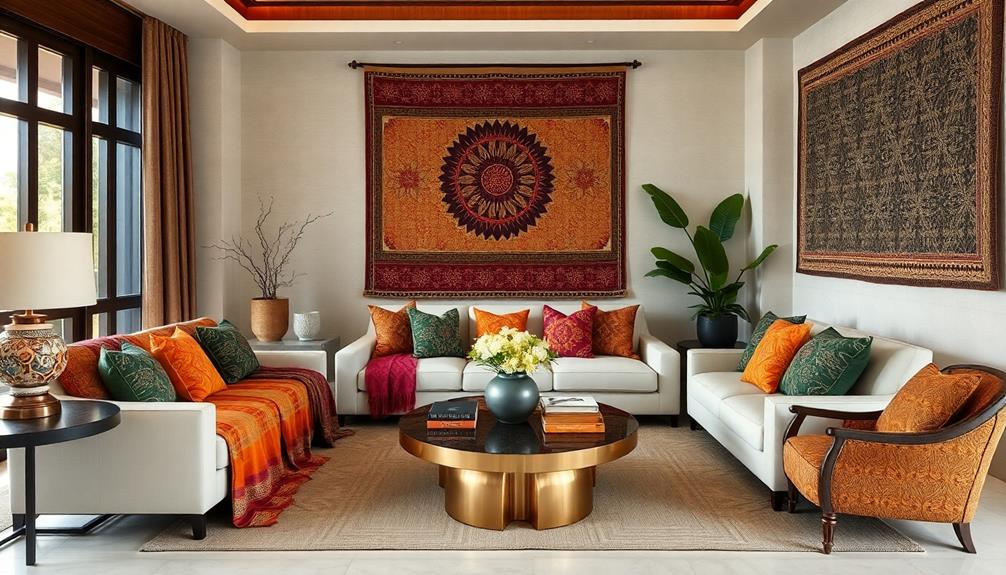
Incorporating traditional textiles into modern design can transform your space, adding layers of cultural richness and intricate craftsmanship. By using Indonesian textiles like batik and ikat, you not only elevate your interior aesthetic but also bring forth a rich cultural heritage that resonates with global sophistication.
Vibrant color palettes inspired by these textiles—think deep blues and earthy tones—create a warm, inviting atmosphere that enhances your interior's perceived value. Textiles such as songket, with their luxurious gold and silver threads, can serve as stunning upholstery or decorative accents, offering a unique touch of opulence that distinguishes your space from conventional designs.
Layering various traditional textile patterns and textures, like batik prints and woven rugs, introduces depth and visual interest, making your environment feel curated and expensive.
Additionally, integrating natural materials with these textiles not only supports sustainable design practices but also connects your interior to the exquisite beauty of Indonesian craftsmanship, elevating overall elegance.
Color and Texture in Interiors

A thoughtfully curated color palette and rich textures can dramatically transform your interior space, creating an inviting and dynamic atmosphere. The vibrant colors of Indonesian textiles, like rich reds and deep blues, infuse energy into your home, reminiscent of traditional Indonesian art. By incorporating intricately patterned batik and ikat textiles into your upholstery and wall hangings, you not only add depth but also artistic flair that makes your space visually striking.
| Color | Texture | Effect |
|---|---|---|
| Rich Reds | Woven Rugs | Creates warmth and vibrancy |
| Deep Blues | Cushions | Evokes calm and sophistication |
| Earthy Tones | Tapestries | Connects with nature and comfort |
| Intricately Patterned | Wall Hangings | Serves as stunning focal points |
| Layered Textures | Upholstery | Enhances visual interest |
The intricate designs serve as statement pieces that elevate your space, giving it an air of luxury. Textural diversity, achieved through these textiles, creates layers that enhance both comfort and design impact, reflecting the craftsmanship of local artisans. Embrace these elements to craft a sophisticated interior that resonates with elegance.
Sustainable Design With Natural Materials
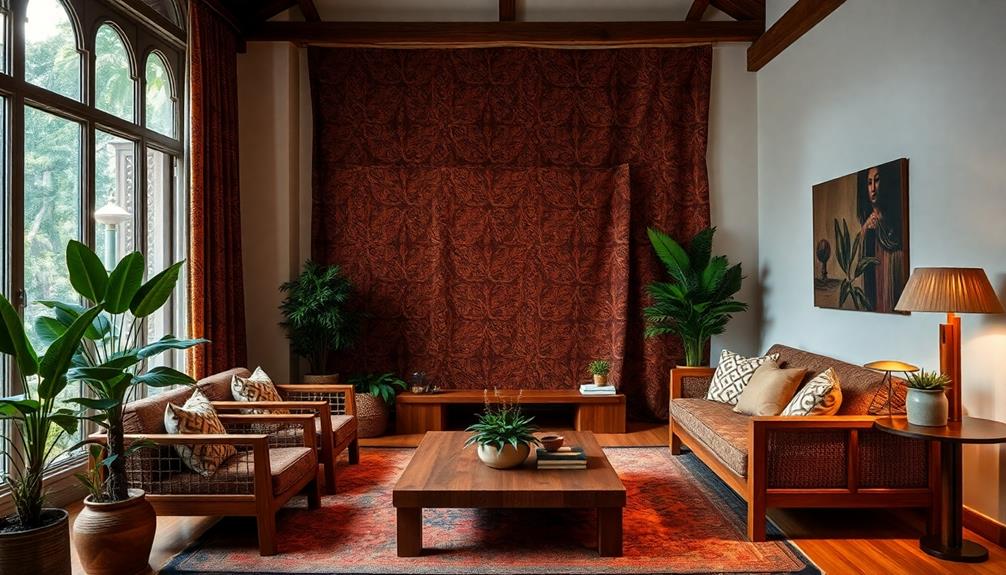
Sustainable design thrives on the use of natural materials that not only enhance the beauty of your space but also promote eco-friendly practices. By incorporating materials like rattan and bamboo, you add character and warmth to your interiors while supporting sustainable sourcing.
These elements connect your design to nature, creating a serene atmosphere that feels inviting.
Antique wood is another fantastic choice, offering both comfort and a sense of history. This choice not only reinforces the importance of preserving fragile heritage but also enriches your space with timeless elegance.
Traditional textiles, such as batik prints, elevate upholstery, cushions, and wall hangings, providing a cultural identity that resonates deeply.
To infuse authenticity and energy into your design, select vibrant colors inspired by local textiles and landscapes. Rich reds and deep blues can transform a room, making it feel alive.
Finally, emphasize texture through layered textiles—think richly woven rugs and intricate tapestries. This approach creates a cohesive and immersive experience, reflecting sophistication and attention to detail.
Innovative Uses in Fashion

With their rich cultural heritage and unique craftsmanship, Indonesian textiles like batik and ikat are making waves in the fashion industry. Designers are increasingly incorporating these textiles into high-end collections, transforming traditional patterns into modern, wearable art. By reinterpreting batik designs, you'll find elegant pieces that resonate with contemporary consumers while honoring their cultural significance.
Indonesian textiles are especially appealing in the eco-conscious luxury market. Their integration of sustainable practices, such as using organic dyes and supporting artisan families, enhances their desirability. Batik gained global recognition when UNESCO listed it as an Intangible Cultural Heritage of Humanity, further solidifying its status in the fashion world.
Innovative collaborations between designers and educational institutions are pushing the boundaries, allowing fresh interpretations of batik to emerge. This not only advances the textile's role in contemporary fashion but also guarantees that its traditional roots remain intact.
As you explore the world of high fashion, consider how these unique textiles can elevate your wardrobe, adding a touch of cultural richness and artisan craftsmanship that truly stands out. Embrace the beauty and story behind Indonesian textiles; they're more than just fabric—they're a celebration of heritage.
Reviving Traditional Craftsmanship

Reviving traditional craftsmanship in Indonesian textiles is vital for preserving the intricate techniques that define this rich cultural heritage. By focusing on methods like batik and ikat, you're not just appreciating beautiful fabrics; you're honoring generations of artisans who've perfected their skills over time.
The meticulous process of crafting batik, which involves labor-intensive wax-resist dyeing, can take days to complete a single piece. This dedication reflects the deep-rooted traditions of the archipelago.
Today, many contemporary designers are collaborating with local artisans, ensuring that reviving traditional craftsmanship remains relevant in modern fashion. These partnerships blend the old with the new, creating sustainable batik products that appeal to today's consumers while respecting time-honored techniques.
Furthermore, using natural dyes and organic materials not only supports sustainable practices but also enhances each piece's authenticity.
Educating younger generations about these traditional textile-making techniques is essential. By doing so, you help maintain the craftsmanship and cultural significance of Indonesian textiles.
As you incorporate these unique textiles into your space, you're not just decorating; you're participating in a movement that values heritage, sustainability, and artistry.
Frequently Asked Questions
What Are the Famous Textile in Indonesia?
In Indonesia, you'll find famous textiles like ikat, songket, and batik. Each boasts unique techniques and patterns, reflecting cultural heritage. These textiles not only tell stories but also highlight the region's rich artistic traditions.
What Is a Form of Textile Design From Indonesia?
One prominent form of textile design from Indonesia is Batik. You'll love how it uses a wax-resist dyeing technique to create intricate patterns, reflecting the rich cultural heritage and artistic traditions of the region.
What Is the Ikat Technique in Indonesia?
The ikat technique involves tie-dyeing threads before weaving them into patterns. You'll see unique designs and vibrant colors, showcasing the artisan's skill and reflecting the rich cultural heritage of Indonesia's diverse regions.
What Is Very Unique Process of Dyeing Fabric in Indonesia?
Did you know that Indonesia boasts over 300 distinct dyeing techniques? You'll discover that traditional methods, like batik and ikat, use natural materials and labor-intensive processes, creating vibrant textiles that reflect the country's rich cultural heritage.
Conclusion
In the garden of interior design, Indonesian textiles are the vibrant flowers that bloom with elegance. By weaving ikat and batik into your space, you're not just decorating; you're telling stories of culture and craftsmanship. Each piece whispers secrets of tradition while adding a touch of luxury. Embrace these rare fabrics, and watch your home transform into a sanctuary that feels both rich and inviting, where every thread is a step towards sustainable beauty.
